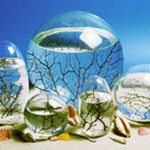What is the relationship between plants and colored light? Well, the color of light will affect a plants growth either negatively or positively, I will explore this relationship throughout the paper.
Light is very important in a plant’s life. Without light a plant could not grow, reproduce, or produce food and building materials. So all plants would eventually die off if there was no light for them to use… which unfortunately would lead to the eventual death of almost all life on earth. You might ask how could the death of seemingly unimportant organisms such as plants could lead to the death of almost all organisms on earth( not counting the absence of light on earth, this is hypothetical). Well there are two reasons why this would happen. The first reason is plants are the only organism that produces its own food. All other organisms have to take energy from something else but plants get their energy directly from the sun so when animals eat plants they get energy that other animals get when they eat the animal that ate the plants and so on and so on. The second reason why the death of plants would lead to the death of most organisms is we would suffocate. You see, plants produce oxygen when they go through photosynthesis (the process they use to get energy from the sun), in fact plants are the only organisms that produce oxygen (including algae and some single celled bacteria). Every other organism produces carbon dioxide and uses oxygen so all the oxygen in the world would eventually be used up and we would suffocate.
Photosynthesis is how plants produce energy from the sun and give off oxygen into the atmosphere. So photosynthesis is the reason why plants are so important to the world and is the reason why plants would die if we suddenly stopped getting light. Photosynthesis takes place in the chloroplast organelle. Each cell contains 40 to 50 chloroplasts, and each leaf has tens of thousands of cells. Each chloroplast is divided into many small, disklike compartments called thylakoids which are arranged like little stacks of quarters or pancakes. Within the thylakoids is the chlorophyll and other enzymes that are used to absorb the light needed for photosynthesis to work. Those are divided into two types of units known as Photosystem I and Photosystem II. Every chloroplast contains millions and millions of chlorophyll and enzyme molecules. (Encarta-“Photosynthesis”)
Photosynthesis is a very complex process and it involves 2 stages, the Light-Dependent Reaction and the Light-Independent Reaction. In the Light-Dependent Reaction (stage 1) the light is absorbed by the chloroplasts and turned into chemical energy contained in two molecules used in the second stage of photosynthesis. In the Light-Independent Reaction (stage 2) one of the molecules provides the hydrogen atoms to make glucose and the other molecule gives enough energy to make glucose. The first stage starts when light strikes Photosystem I and excites the electrons causing the energy to pass from molecule to molecule. Then as energy passes through various molecules it gains energy which it then uses to form the 2 molecules NADPH (stands for something very long) and ADP (also stands for something long) which contain the chemical energy formed during stage 1 of photosynthesis. The second stage of photosynthesis begins when carbon dioxide links up with a sugar molecule known as RuBP in the fluid surrounding the thylakoids (known as the stroma) in a process called carbon fixation. After this the carbon dioxide/ RuBP molecules form 6 new molecules by combining with an enzyme. Then these new molecules combine with ADP, NADPH, and enzymes in order to rearrange the parts of these molecules to form 1 glucose molecule and five RuBP molecules (used to start over the process). This occurs in every chloroplast in every cell in every leaf over and over again as long as the necessary ingredients are available. There are some variations in this process for plants that live in hot, dry environments (Encarta-“Photosynthesis”).
Light is “the form of energy visible to the eye that is radiated by moving charged particles” (Encarta-“Light”). Light is made of electromagnetic vibrations which have wavelengths distributed evenly between 14 to 30 millionths of an inch. The brightness of light is determined by the intensity of the vibrations; very intense vibrations give bright, white light, but if there is no intensity there is no light or the light is black. The hue of the light is determined by the wavelength. Light with a wavelength of 30 millionths of an inch is seen as red light, while light with a wavelength of 14 millionths of an inch is perceived as violet light. (Encarta-“Color”).
The most effective kind of light for photosynthesis is certain red and blue wavelengths as they contain the right amount of energy to charge the chlorophyll electrons to a higher energy level. The plant also contains other pigments that absorb more blue, red, orange, and yellow wavelengths. Since none of the pigments absorb green wavelengths plants appear green when we look at them. (Encarta-“Photosynthesis”).
We only see color in most everyday objects because objects absorb certain wavelengths of light and reflect or transmit other wavelengths of light so that we see the wavelength that is reflected back to us. For example, when you look at this paper it looks white because it reflects back all light, but when you look at the words you are seeing the absorption of all light touching it. Darker colors absorb more while lighter colors absorb less light (Encarta- “Colors”).
In this research paper I talked about how plants require light to grow, that plants go through photosynthesis in their chloroplasts, and that plants have 2 stages in photosynthesis. The concepts. I talked about mainly involving colors and light were that plants are green because chlorophyll absorbs red and blue light while reflecting green light, that colored light has different properties than white light, and the reason why we see colors is because objects absorb different wavelengths of light.
“Color.” Microsoft Encarta Online Encyclopedia 2005. 30 Jan 2006. Microsoft Corporation. .
“Light.” Microsoft Encarta Online Encyclopedia 2005. 30 Jan 2006. Microsoft Corporation. .
“Photosynthesis.” Microsoft Encarta Online Encyclopedia 2005. Jan 30 2006. Microsoft Corporation .






